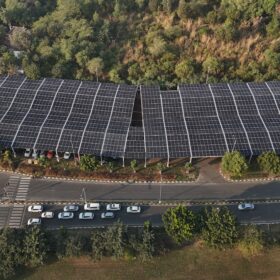As the world scouts for sustainable energy solutions, India gains from its geography in making the most of renewables. Backed by stimulative government policies, the renewables market has been expanding exponentially in the country.
India’s capability to harness solar power is evident; while the COVID-19 pandemic crisis may have dampened the predictable growth, the forecasts are incredible. The solar power industry in India has gained from indigenous companies, especially manufacturers who are now focused on producing components and technology-backed solutions in the country. The trends in the solar industry are promising and achievable.
Increased access to solar power
More sectors in India are considering solar power as their sustainable source of energy supply. This has been largely possible because of solar panel manufacturers, who spend considerable resources manufacturing solar panels and related components ingeniously, without relying on their Chinese counterparts. India’s dependence on Chinese solar energy products was a huge hindrance in effectively pricing components like wind turbines and panels.
Going forward, we will see more use of solar power, not merely for the commercial and residential sectors but also households. The access to solar power resources is expanding and likely to improve.
More support from government
The Ministry of New and Renewable Energy (MNRE) is focused on the National Solar Mission, which was initiated in 2010. The mission currently targets 100 GW of installed solar electricity capacity by next year (2022), and several policies are being launched for that. For manufacturers and players in the solar industry, this may mean more subsidies and other schemes, which will help in minimizing the R&D costs and upfront installation expenses. With loan support for vested parties, it is predictable that the interest in the solar industry will inflate exponentially.
Digitalization and AI
From research to production and infrastructure, digitalization is expected to transform every aspect of the solar industry. More companies are trying to use machine learning and artificial intelligence to improve the commercial viability of their solar projects. The use of data, drones, robots, and software solutions in the renewable sector is an interesting trend, especially when homegrown countries are investing extensively in technology.
Blockchain
Players in the energy market are looking at the potential use of blockchain technology to get direct access to solutions, purchases, and products. Blockchain will allow investors, manufacturers, and solar panel sellers to buy and sell directly, eliminating the need for intermediaries. Besides the cost benefits, Blockchain will also allow companies to implement solar energy solutions more efficiently within a budget, especially for the commercial sector.
Grid parity
When the world is dealing with unprecedented consequences of climate change, “grid parity” is a term that everyone should know about. Grid parity is when a renewable energy source, such as wind or solar power, costs as much or less than conventional energy sources, such as petroleum.
With significant investments, government subsidies, and policy boosts, the solar industry in India is expected to reach grid parity soon. It is expected that solar energy will eventually generate power that would cost less than thermal power in years to come. Existing solar energy projects are already headed in that direction.
Diminishing cost of solar panel components and hardware
The average prices of solar panels, parts, components, and hardware have decreased drastically in the last decade. The dramatic change can be attributed to solar energy investors and homegrown manufacturers that have invested heavily in in-house production capacities. With more solar players willing to deliver to smaller manufacturers and start-ups, the cost of hardware and solar panels is set to reduce further. A sweeping change is also expected in the solar panel manufacturing sector, with higher outputs to cater to international and domestic demands.
Emergence of floating solar plants
Considering that land is an expensive and scarce resource in India, floating solar photovoltaic (FSPVs) plants are emerging as the new means to harness solar energy. Companies are exploiting the idea of solar PV installations on an artificial basin, such as a water body. Compared to standard installations, floating solar PV modules produce more output, which is another advantage concerning large-scale energy production.
Building-integrated photovoltaics
Although in its early stages, building-integrated photovoltaics (BIPV) is expected to increase in the Indian landscape. This kind of solar technology relies on using photovoltaic building materials within the architecture, adding to the property’s energy efficiency. As companies explore the basics of BIPV for the targeted Indian market, there could be an evident change in how buildings are designed.
Compared to 2010, when India was producing 10 MW solar energy, the installed solar capacity has reached more than 42 GW, a huge mark up the expected line. With evolving trends, more companies and investors are likely to enter the renewable sector, which may mean cost-effective access to solar energy, not just for industrial needs but also for large-scale mass requirements. The increasing prices of petroleum is already a looming concern for the Indian customer. Solar energy and other renewable resources could be the alternative for every stakeholder.
The views and opinions expressed in this article are the author’s own, and do not necessarily reflect those held by pv magazine.
This content is protected by copyright and may not be reused. If you want to cooperate with us and would like to reuse some of our content, please contact: editors@pv-magazine.com.








By submitting this form you agree to pv magazine using your data for the purposes of publishing your comment.
Your personal data will only be disclosed or otherwise transmitted to third parties for the purposes of spam filtering or if this is necessary for technical maintenance of the website. Any other transfer to third parties will not take place unless this is justified on the basis of applicable data protection regulations or if pv magazine is legally obliged to do so.
You may revoke this consent at any time with effect for the future, in which case your personal data will be deleted immediately. Otherwise, your data will be deleted if pv magazine has processed your request or the purpose of data storage is fulfilled.
Further information on data privacy can be found in our Data Protection Policy.